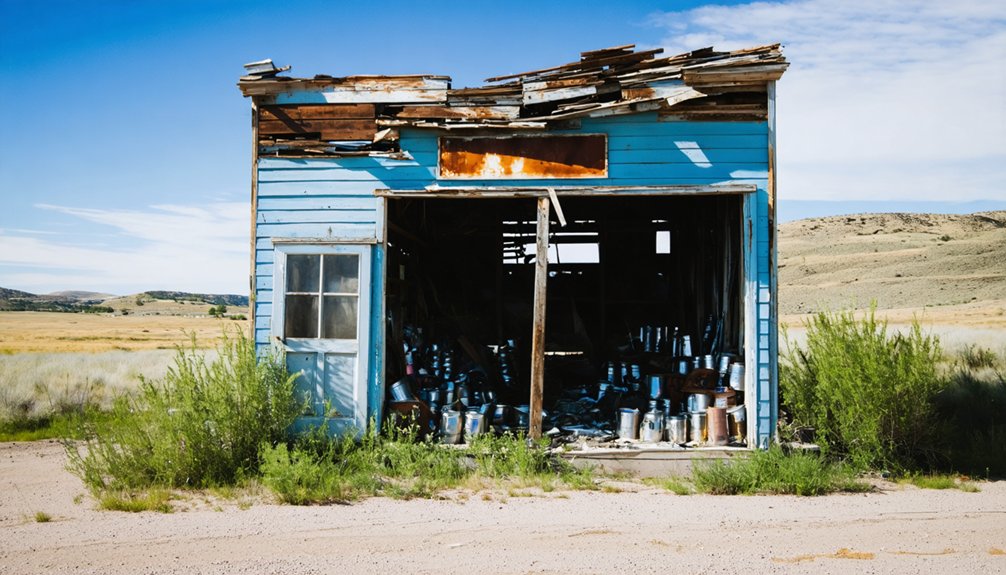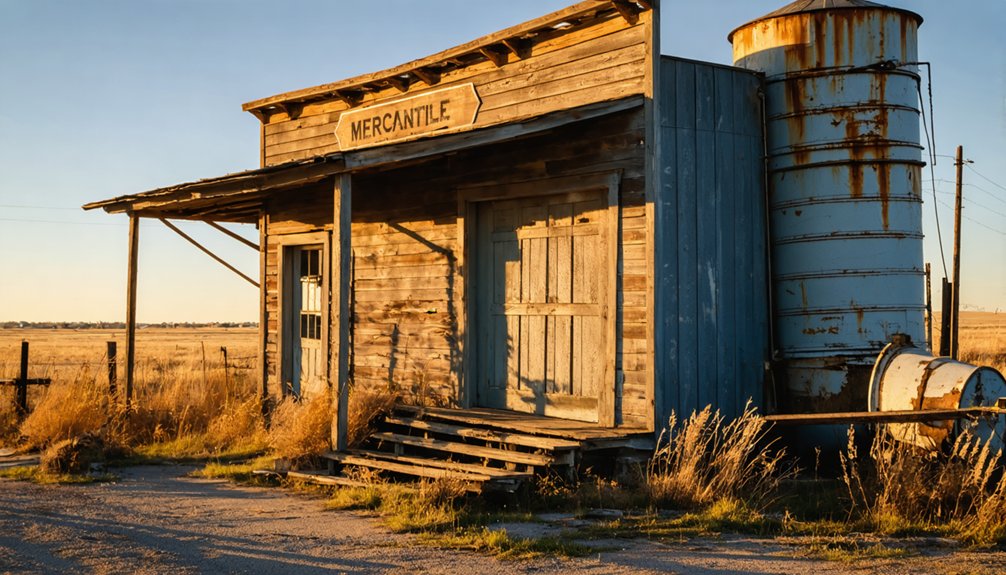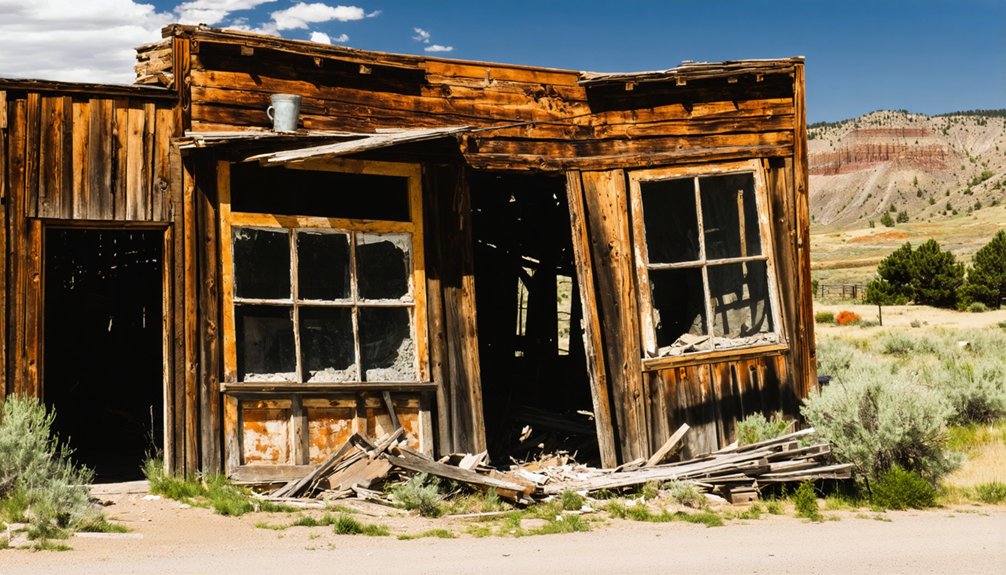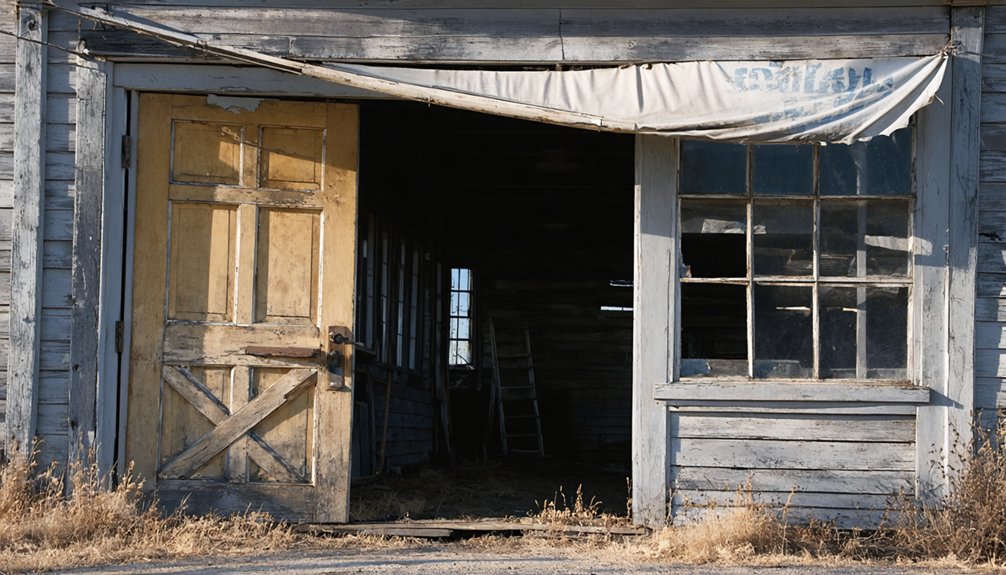You’ll find Quartz City nestled in South Dakota’s Black Hills, where it emerged during the 1878 gold rush. The town rapidly grew from tents to a bustling mining settlement, with operations producing $1.5 million in gold by 1876. The Chicago and North Western Railway connected the T-shaped town to wider markets, but post-WWII shifts in transportation and cheaper building materials led to its decline. Today, crumbling foundations and abandoned mine shafts tell stories of frontier resilience and untold riches.
Key Takeaways
- Founded in 1878 during the Black Hills gold rush, Quartz City thrived on gold mining with production reaching $1.5 million by 1876.
- The town’s economy centered around quartz and gold mining operations, employing 500 men by 1890 in various quarries.
- Railroad connections initially supported growth, but post-WWII shifts to automotive transportation contributed to the town’s eventual decline.
- Remaining structures include crumbling stone foundations, deteriorating brick walls, and abandoned mining equipment showing the town’s industrial heritage.
- The ghost town now attracts tourists interested in mining history, though poor road conditions make access challenging.
The Rise of a Mining Frontier Town
As prospectors flooded into the Black Hills following major gold strikes in the 1870s, Quartz City emerged in 1878 as one of Lawrence County, South Dakota’s promising mining settlements.
You’ll find its origins deeply rooted in the region’s quartz and gold discoveries, which sparked a wave of frontier development throughout the Black Hills area.
The town’s early community resilience showed in its quick shift from basic tents and log cabins to a bustling frontier settlement. The area’s miners produced an impressive 1.5 million dollars in gold during 1876 alone. Like nearby Keystone, the town saw the establishment of extensive flume systems for hydraulic mining operations.
While maintaining historical preservation wasn’t a priority during those enthusiastic gold-seeking days, you can imagine the determined spirit of miners and entrepreneurs who built this raw frontier town.
In those gold-fevered days, preservation took a backseat to the raw ambition of frontier builders and dreamers.
The settlement attracted a diverse mix of prospectors, business owners, and service providers, all contributing to a growing community that included saloons, gambling houses, and essential frontier businesses.
Mining Operations and Economic Growth
While early prospectors relied on basic panning techniques, Quartz City’s mining operations rapidly industrialized through the installation of Blake Crushers and Bolthoff Ball Pulverizers in the late 1870s.
You’d have seen mining equipment evolve from these initial crushers to larger stamp mills capable of processing tremendous ore volumes. The town’s economic sustainability hinged on efficient ore processing, with tramways and automated systems moving ore from shafts to mills. Notable operations like the Father Desmet mine led early quartz mining developments in 1876, paving the way for future enterprises. The Golden Reward Mining became one of the region’s most successful operations by consolidating numerous individual claims.
Mining companies invested heavily in the region, often putting up $25,000 or more to acquire promising claims. The payoff proved substantial – you could find ore valued between $12 and $20 per ton, though processing challenges varied based on whether you encountered free-milling quartz or more stubborn refractory ores requiring advanced treatment methods.
Life in Early Quartz City
When prospectors and miners first settled in Quartz City during the 1870s, you’d have found a largely male population living in basic shelters built from local quartzite stone and timber. The settlers valued quartzite for its extreme durability when constructing their homes.
Your daily routines would’ve revolved around the quarries, with long hours of backbreaking work followed by evenings at the local saloons or community gatherings in makeshift halls. The quarries employed nearly 500 men by 1890, showing the rapid growth of the mining operations.
You’d have faced challenging living conditions, relying on wells or streams for water that was often tainted by mining operations.
Food came mainly through railway shipments, supplemented by small garden plots and livestock.
Medical care was scarce, and you’d have depended on neighbors for help during illnesses.
Despite these hardships, you’d have found strength in the tight-knit community, where information spread by word-of-mouth and residents looked after one another.
Transportation and Infrastructure
You’ll find that Quartz City’s transportation backbone centered on the Chicago and North Western Railway, which connected the town to broader markets while facilitating essential mining shipments.
Rail infrastructure included local depots and warehouses that served multiple community functions, from mail delivery to informal gatherings. Similar to City of Presidents Rapid City, the railway played a crucial role in shaping the region’s early development and cultural identity. Located in western South Dakota, this region became a significant hub for mining operations and transportation networks.
The town’s eventual decline paralleled the post-World War II shift from rail to automotive transportation, though remnants of early freight routes and mining trails can still be traced through the area.
Railroad Access and Decline
As the Rapid City, Black Hills and Western Railroad completed its line to Mystic in 1906, Quartz City gained crucial transportation access that would shape its destiny.
The railroad impacts were immediately felt, connecting the town to critical markets and supporting its mining operations. Following the path established by the first steam locomotive in Chicago in 1848, these rail connections proved vital for the region’s development. The town’s layout followed the common T-shaped pattern, with commercial buildings arranged perpendicular to the tracks. You’d have seen multiple railroads, including the Chicago, Burlington and Quincy, establishing a robust network by 1907.
But the transportation evolution after World War II spelled trouble for Quartz City’s rail connections. As automobiles and trucks gained dominance, rail traffic dwindled.
The Dakota Southern Railway’s eventual cessation of operations, combined with track removals and infrastructure decay, severely isolated the town. This declining rail access proved devastating, accelerating Quartz City’s transformation into a ghost town as both commerce and population shifted away.
Mining Transport Routes
The extensive mining transport network in Quartz City linked underground operations to surface facilities through an intricate system of narrow-gauge railways and specialized equipment.
You’d find approximately 80 meters of steel rail tracks running through the underground chambers, where electric and compressed air-powered locomotives moved ore, equipment, and materials efficiently between work sites.
The transportation logistics relied heavily on one-ton rail cars protected by timber planking and steel guards for worker safety.
This rail system connected directly to the surface processing areas, where gravity-fed ore movement helped minimize power consumption.
For external transport, freight roads connected Quartz City to major railheads, while guarded stagecoaches managed by companies like Wells Fargo handled the secure transport of refined gold to distant markets.
Local Road Development
While mining transport relied on specialized rail systems, road development around Quartz City faced significant engineering challenges in the rugged Black Hills terrain.
You’ll find that early local infrastructure struggled against harsh weather, isolation, and difficult geography. Road maintenance proved especially demanding, as crews battled blizzards and extreme conditions while trying to keep essential routes passable.
The region’s quarries played a key role in road construction, with locally sourced quartzite and granite initially serving as primary building materials.
You’d have seen a dramatic transformation by the 1930s, when the area’s network expanded to include both hard-surface and gravel roads. This development was part of South Dakota’s broader commitment to modernizing its transportation system, which would eventually grow to over 83,000 miles of roads.
The Decline of Quartz City
Multiple economic factors converged to trigger Quartz City’s dramatic decline in the late 19th century. The Panic of 1893‘s economic impacts hit the town hard, crushing railroad financing and mining investments.
You’ll find the town’s failed attempts at community resilience reflected in these key developments:
- The emergence of cheaper paving materials like concrete and asphalt by 1912 devastated quartzite’s market value.
- Fires destroyed critical infrastructure while the dwindling population couldn’t sustain rebuilding efforts.
- Mining companies’ inability to adapt to technological changes led to widespread business closures.
The town’s singular dependence on quartzite mining proved fatal. When competing materials gained popularity, Quartz City couldn’t pivot to alternative industries.
Without a stable economic base, essential services shuttered and residents fled, accelerating the town’s transformation into a ghost town.
Architectural Remnants and Ruins

Scattered throughout Quartz City’s abandoned landscape, architectural remnants tell a stark story of the town’s bygone prosperity.
You’ll find shells of residential buildings with crumbling stone foundations and deteriorating brick walls, while commercial structures along the main street reveal faded architectural styles through their partial signage and broken storefronts.
Mining-related buildings stand as skeletal frameworks of timber and metal, offering glimpses of the town’s industrial past.
The preservation challenges are evident as you explore the ruins.
Weather and time have stripped most roofs away, leaving interiors exposed to the elements.
Local historical societies face ongoing battles against natural decay, with many structures reduced to foundations and rubble.
You’ll notice how locally sourced materials – stone, brick, and timber – reflect typical 19th-century construction methods throughout the remaining structures.
Mining Heritage and Historical Significance
You’ll find evidence of the region’s quartz mining heritage through the remnants of stamp mills and compressed air systems that replaced animal power in 1901, enabling deeper extraction of gold-bearing ore that yielded $12-20 per ton.
The site’s technological evolution included Charles Merrill’s cyanidization process, which boosted gold recovery rates to 94%, while the introduction of automatic ore elevators and underground tramways streamlined the movement of extracted materials.
Within the area’s extensive network of mine shafts, which eventually reached depths of 6,800 feet by 1975, you can trace the progression from early mercury amalgamation techniques to more sophisticated hardrock mining operations that defined Quartz City’s peak production era.
Mining Tools and Techniques
The technological evolution of mining in Quartz City showcased both innovation and efficiency throughout its operational history.
The mining machinery evolution transformed from simple stamp mills to sophisticated operations featuring Blake Crushers and Bolthoff Ball Pulverizers, while hydraulic mining techniques utilized extensive flume and trestle systems reaching heights of 200 feet.
You’ll find these remarkable advancements reflected in three key developments:
- The introduction of compressed air locomotives, replacing animal-powered carts for underground transport
- Implementation of cyanidization, which improved gold recovery rates to 94%
- Installation of automatic elevators and enclosed tramways that revolutionized ore movement from deep shafts reaching 6,800 feet
These technological leaps defined Quartz City’s mining legacy, marking its shift from primitive extraction methods to industrial-scale operations.
Quartz Extraction Operations
Mining heritage in Quartz City traces back to mid-1870s claims in the northern Black Hills, where prospectors first recognized gold-bearing quartz veins near Deadwood Gulch.
You’ll find the Hidden Treasure Mine stood as one of the region’s pioneering operations, yielding $20,000 in gold during its first year of crushing operations in 1876.
Quartz processing methods evolved from basic stamp mills to sophisticated cyanidation techniques by the early 1900s, boosting gold recovery rates to 94%.
Mining safety practices became essential as operations expanded to depths beyond 3,000 feet, requiring advanced ventilation systems.
Despite devastating fires in 1907 and 1919, companies like the Black Hills Gold Mining Company and Harney Peak Tin Company maintained extensive operations, managing up to 1,100 claims while building reduction plants that transformed the region’s industrial landscape.
Ghost Town Tourism and Exploration

While ghost town tourism once flourished across America’s abandoned settlements, Quartz City now faces significant challenges in attracting visitors amid declining international and domestic travel.
You’ll find deteriorating infrastructure and limited access roads making ghost town exploration increasingly difficult, though this offers a more authentic experience for adventurous spirits seeking unspoiled sites.
If you’re planning to explore Quartz City, consider these essential factors:
- Poor road maintenance requires high-clearance vehicles and careful navigation
- Limited emergency services mean you’ll need thorough preparation and self-reliance
- Fewer guided tours available, so you must research safety protocols and historical points of interest beforehand
The silver lining? Social media’s growing influence and interest in off-the-beaten-path destinations are creating new opportunities for responsible explorers to discover Quartz City’s forgotten treasures.
Preserving the Past: Documentation Efforts
As deteriorating ghost towns face mounting preservation challenges, dedicated documentation efforts have emerged to safeguard Quartz City‘s historical legacy.
You’ll find local historical societies working alongside South Dakota State Historical Society archivists to catalog the town’s remaining structures, artifacts, and oral histories. These documentation challenges are met through thorough archival strategies, including high-quality photography, digital mapping, and detailed site surveys.
Through collaborative efforts, you can now access digitized records of Quartz City’s mining history, complete with photographs of deteriorating structures and foundations.
While private land ownership and ongoing vandalism create obstacles for preservationists, multimedia presentations and virtual tours allow you to explore this Black Hills ghost town remotely while protecting its fragile remains from further damage.
Legacy of the Black Hills Mining Era

As you explore Quartz City’s ruins today, you’ll find evidence of the Black Hills’ dramatic boom-and-bust mining cycles that transformed the region’s economy between 1874-2001.
The area’s mining heritage remains visible through preserved structures, mining equipment, and the cultural imprint left on communities like Lead and Deadwood.
While the Homestake Mine’s closure in 2001 marked the end of large-scale gold mining in the Black Hills, the region’s mining legacy continues through museums, historic sites, and the enduring influence on local traditions.
Mining’s Economic Boom Cycles
When Lt. Col. George Custer’s 1874 expedition discovered gold in the Black Hills, you would’ve witnessed one of America’s most dramatic economic transformations.
The region’s mining techniques evolved rapidly through distinct boom cycles:
- Initial placer mining along French Creek and Deadwood Creek sparked the first rush, creating instant wealth for early prospectors.
- Hard rock mining took over by 1880 as surface gold depleted, requiring major corporate investment and advanced extraction methods.
- The introduction of chlorination and cyanide processes in the 1890s extended mining viability, though economic fluctuations caused many smaller operations to fail.
While most individual miners saw their dreams fade, the Homestake Mine near Lead proved extraordinarily resilient, operating for 126 years until 2001.
The boom’s wealth concentrated among corporate investors, leaving behind ghost towns like Quartz City as evidence to mining’s volatile nature.
Cultural Heritage Lives On
Through decades of preservation efforts, the Black Hills’ mining heritage remains etched in both landscape and memory.
You’ll find tangible links to this rich past in Quartz City’s abandoned mine shafts, stamp mills, and weathered equipment that tell stories of 19th-century innovation. The region’s cultural traditions live on through festivals and reenactments in towns like Deadwood, where mining-era customs come alive.
The Black Hills Mining Museum showcases the community resilience that defined these boomtowns, preserving artifacts and oral histories from diverse populations who sought their fortunes here.
Archaeological studies of sites like Quartz City continue revealing details about miners’ daily lives, while preserved landscapes – from tailings piles to prospecting sites – stand as silent witnesses to the determination that shaped this frontier territory.
Frequently Asked Questions
Are There Any Reported Paranormal Activities or Ghost Sightings in Quartz City?
While you won’t find documented ghostly encounters specifically in Quartz City, you’ll discover numerous spectral sightings in surrounding Black Hills ghost towns, where whispers and shadowy figures are commonly reported.
What Valuable Artifacts Have Been Discovered by Metal Detectorists at the Site?
One person’s trash is another’s treasure! You’ll find artifacts discovered through metal detecting include ancient arrowheads, mining tools, rusted metal sheets, storage tanks, tool stones, bottles, and various quartzite implements.
Was Any Gold Found in Quartz City Despite Its Focus on Quartz?
You’ll find gold was definitely extracted here, with quartz mining operations yielding $12-$20 per ton from hard-rock deposits, though recovery proved challenging compared to Homestake’s free-milling ore deposits.
Which Famous Outlaws or Notable Historical Figures Visited Quartz City?
As you peer into Quartz City’s dusty past, you won’t find any documented outlaw legends or famous historical visitors. Historical records show it was primarily a working quarry town without notable personalities.
Does Anyone Legally Own the Quartz City Site Today?
You can’t definitively determine current ownership since there’s no verifiable record of this site’s existence or any documented land disputes in South Dakota property records or historical archives.
References
- https://www.sdpb.org/rural-life-and-history/2023-08-21/some-black-hills-ghost-towns-and-their-origins
- https://www.youtube.com/watch?v=_0WNYsFLSLA
- https://www.sdhspress.com/journal/south-dakota-history-2-2/some-black-hills-ghost-towns-and-their-origins/vol-02-no-2-some-black-hills-ghost-towns-and-their-origins.pdf
- https://www.powderhouselodge.com/black-hills-attractions/fun-attractions/ghost-towns-of-western-south-dakota/
- https://www.blackhillsbadlands.com/blog/post/old-west-legends-mines-ghost-towns-route-reimagined/
- https://westernmininghistory.com/towns/south-dakota/silver-city/
- https://en.wikipedia.org/wiki/List_of_ghost_towns_in_South_Dakota
- https://www.legendsofamerica.com/south-dakota-ghost-towns/
- https://ruralresurrection.com/ghost-towns-mystic-south-dakota/
- https://www.sdpb.org/rural-life-and-history/2023-08-28/the-boom-and-bust-of-central-city



